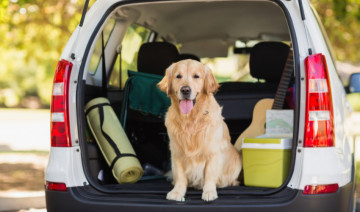
Many dogs love car rides and behave well in vehicles as they see and smell the changing scenery. But what if your dog suffers from car sickness and motion sickness? Pet owners who understand these conditions can easily take steps to keep their dog feeling comfortable and avoid illness on car trips.
Car Sickness in Dogs
Just as in humans, car sickness is usually caused by an inner ear imbalance when a dog cannot adjust to different and conflicting sensations from its eyes, paws, and inner ear. This is a common problem in dogs, and is most often seen in puppies or younger dogs that may not yet have a fully developed inner ear or have perfected their own balance. Similarly, the stress of car travel can bring on motion sickness. Furthermore, motion sickness is not limited to a car, and dogs might get sick on a boat or during air travel when their equilibrium is disturbed.
Dogs cannot tell you when they are feeling nauseous, but there are car sickness symptoms you can stay alert for, such as:
- Vomiting or diarrhea
- Whining
- Excessive drooling
- Excessive yawning
- Pacing, shaking, or other signs of anxiety
- Panting
- General lethargy or reluctance to move
These symptoms can signal a variety of other illnesses or conditions, but if the dog’s symptoms always appear when traveling and disappear quickly after the travel ends, motion sickness may be to blame.
Treating Dog Motion Sickness
There are several options for treating motion sickness and car sickness in dogs. While the effectiveness of each option will vary based on the severity of the animal’s sickness, popular treatments include:
- Acclimatization Training – Many dogs get carsick simply because they are not used to the vehicle’s motion. Taking small trips before longer travel can help your dog get used to the new environment and adjust to the motion more easily, minimizing car sickness.
- Happy Trips – Anxious dogs may associate car trips with unpleasant experiences such as vet visits, and extra anxiety could lead to illness. Take your dog along on happy trips, such as visits to a dog park or to get a pup cup treat from a local restaurant to reduce that anxiety.
- Fun Distractions – If a dog is bored, the symptoms of carsickness could become more acute. Offer a car-only favorite toy or use your dog’s favorite toys to provide distraction that can occupy your pet and minimize the symptoms of motion sickness.
- Feeding Adjustments – Some dogs suffer less from carsickness if they have a light meal an hour before a trip, while others may need to refrain from eating for 8-12 hours before traveling. Learn what feeding adjustments work best to curb your dog’s carsickness.
- Breaks – If a long trip is necessary, taking breaks during the trip can ease carsickness and help your dog feel more comfortable. This is also a great time for a potty break, quick walk, or refreshing drink to help your dog feel at ease.
- Fresh Air and Ventilation – Lowering the vehicle’s windows 1-2 inches can provide fresh air and a cooling breeze to ease carsickness. The scents carried into the car can also be a distraction for a dog with a sensitive nose, minimizing illness and discomfort.
- Face Forward – Having your dog face forward can minimize the disorientation that contributes to carsickness. Use a specialized harness or dog seat belt to keep your pet facing forward, or be sure their crate faces forward for less motion disruption.
- Medication – For dogs with severe motion sickness, a veterinarian may prescribe anti-anxiety or anti-nausea medication to be used prior to travel. This should only be used as a last resort, however, and only with a veterinarian’s guidance.
- Stay Calm – If your dog does get ill in the car, do not show frustration or anger at your pet. The animal is already anxious, and your emotions can make the symptoms worse. Instead, clean up as quickly as possible and reassure your pet to sooth their discomfort.
Using multiple techniques to minimize dog carsickness will be most effective. While each dog will have a different reaction to car travel, working to ease discomfort and keep your pet healthy will keep car sickness at bay.
When to See a Veterinarian
Most dogs outgrow carsickness by the time they are a year old, or basic steps can greatly ease their symptoms and make car travel more comfortable. If the symptoms do not disappear rapidly after the travel ends, however, or if the condition occurs suddenly and unexpectedly in an adult dog, it is best to consult a veterinarian about the possibility of other causes, such as ear infections or other problems. If the car sickness is very extreme, or if the vomit or diarrhea is bloody or otherwise unusual, emergency care may be necessary.
Car sickness can be unpleasant for any species, but if your dog suffers from travel illnesses, there are steps that can help. Understanding the condition and taking different steps to ease your pet’s symptoms can make both you and your dog more comfortable with every car trip you take.







Comments